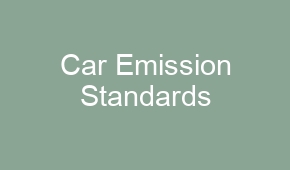Car Emission Standards

Car emission standards are regulations set by governments to limit the amount of pollutants released by vehicles. They aim to reduce air pollution and promote cleaner and more fuel-efficient cars.
Car Emission Standards play a crucial role in mitigating environmental pollution and improving air quality. These standards are set by regulatory bodies to limit the amount of harmful pollutants emitted by vehicles. Meeting these standards is mandatory for car manufacturers, who must adhere to the prescribed emission limits. The implementation of stricter regulations has led to the development of advanced emission control technologies such as catalytic converters and particulate filters. These technologies effectively reduce the emissions of carbon monoxide, nitrogen oxides, and volatile organic compounds from cars. Compliance with emission standards is not only beneficial for the environment but also for public health, as it helps in reducing respiratory diseases and other health hazards associated with air pollution.
| Car Emission Standards: regulations set by governments to limit pollutants released by vehicles. |
| Environmental Impact: emission standards aim to reduce air pollution and mitigate climate change. |
| Global Harmonization: efforts to align emission standards worldwide for greater consistency. |
| Regulatory Bodies: organizations responsible for setting and enforcing car emission standards. |
| Emission Testing: procedures conducted to ensure compliance with the set standards. |
- Greenhouse Gases: emissions targeted by standards to reduce their impact on climate change.
- Catalytic Converters: devices installed in vehicles to reduce harmful emissions.
- Particulate Matter: tiny particles released by vehicles that can cause respiratory problems.
- Scrappage Programs: initiatives encouraging the retirement of old, polluting vehicles.
- Zero-Emission Vehicles: cars powered by alternative fuels or electricity with no direct emissions.
What are car emission standards and why are they important?
Car emission standards are regulations set by governments to limit the amount of pollutants emitted by vehicles. These standards aim to reduce air pollution and improve public health. They typically include limits on pollutants such as carbon monoxide, nitrogen oxides, and particulate matter. Compliance with these standards is important to ensure cleaner air and mitigate the negative impacts of vehicle emissions on the environment and human health.
How do car emission standards vary across different countries?
Car emission standards vary across different countries due to variations in environmental priorities, technological capabilities, and regulatory frameworks. Some countries have stricter standards, requiring vehicles to meet lower emission limits, while others may have more lenient regulations. These variations often reflect the specific air quality challenges and policy goals of each country. International agreements, such as the European Union’s Euro standards and the United States’ EPA regulations, also influence the adoption and harmonization of car emission standards.
What are the main pollutants regulated by car emission standards?
The main pollutants regulated by car emission standards include carbon monoxide (CO), nitrogen oxides (NOx), hydrocarbons (HC), particulate matter (PM), and greenhouse gases (GHGs) such as carbon dioxide (CO2). These pollutants contribute to air pollution, smog formation, and climate change. Car manufacturers are required to develop technologies and implement measures to reduce these emissions and meet the specified limits set by the standards.
How are car emission standards tested and enforced?
Car emission standards are tested through laboratory measurements and on-road testing. Vehicles undergo various tests, including the measurement of tailpipe emissions and the evaluation of onboard diagnostic systems. These tests ensure that vehicles meet the specified emission limits under different driving conditions. Enforcement of car emission standards is typically carried out by regulatory agencies through inspections, random testing, and penalties for non-compliance. Manufacturers are required to certify their vehicles’ compliance before they can be sold in the market.
What are the benefits of stricter car emission standards?
Stricter car emission standards lead to several benefits, including improved air quality, reduced health risks, and lower greenhouse gas emissions. By limiting the pollutants emitted by vehicles, these standards help mitigate the negative impacts of transportation on the environment and public health. They also drive technological advancements in the automotive industry, promoting the development of cleaner and more fuel-efficient vehicles. Additionally, stricter standards can create economic opportunities, such as the growth of the electric vehicle market and the creation of green jobs.
How do car emission standards affect car manufacturers?
Car emission standards significantly impact car manufacturers as they need to invest in research and development to meet the requirements. These standards often require the adoption of new technologies, such as catalytic converters, advanced engine designs, and hybrid or electric powertrains. Compliance with the standards may involve redesigning existing models or phasing out vehicles that do not meet the emission limits. Manufacturers also face financial implications, including potential fines for non-compliance and the need to balance costs with consumer demand for cleaner vehicles.
What is the role of the automotive industry in setting car emission standards?
The automotive industry plays a crucial role in setting car emission standards through collaboration with regulatory agencies and participation in the development of regulations. Car manufacturers provide technical expertise and data to support the establishment of realistic and achievable standards. They also invest in research and development to innovate and improve vehicle technologies that help meet the emission targets. Collaboration between the industry and regulators ensures that the standards are both effective in reducing emissions and feasible for implementation by manufacturers.
What are the future trends in car emission standards?
The future trends in car emission standards include a shift towards stricter regulations to further reduce emissions and promote sustainable transportation. This includes the promotion of electric vehicles (EVs), the development of stricter emission limits for conventional vehicles, and the integration of new technologies such as hydrogen fuel cells. Governments are also focusing on addressing emissions from non-exhaust sources, such as tire and brake wear, to comprehensively tackle the environmental impact of transportation. Additionally, international cooperation and harmonization of standards are expected to continue to facilitate global emission reduction efforts.
How do car emission standards contribute to climate change mitigation?
Car emission standards contribute to climate change mitigation by reducing the amount of greenhouse gases emitted by vehicles. Carbon dioxide (CO2) is a major contributor to climate change, and car emission standards set limits on CO2 emissions from vehicles. By promoting the use of cleaner technologies, such as electric vehicles and hybrid powertrains, these standards help to decrease the carbon footprint of the transportation sector. Additionally, stricter standards encourage the development of more fuel-efficient vehicles, reducing the overall consumption of fossil fuels and further mitigating climate change.
What are the challenges in implementing and enforcing car emission standards?
Implementing and enforcing car emission standards face several challenges, including technological limitations, cost implications, and the need for international cooperation. Developing and implementing new emission reduction technologies can be costly for both manufacturers and consumers. The global nature of the automotive industry requires coordination and harmonization of standards across countries to avoid trade barriers and ensure fair competition. Additionally, monitoring and enforcing compliance with the standards, particularly for in-use vehicles, can be challenging due to the diversity of vehicle types, driving conditions, and the potential for tampering or non-compliance.
How do car emission standards impact consumer choices and affordability?
Car emission standards influence consumer choices by promoting the availability and affordability of cleaner vehicles. Stricter standards drive the development and market penetration of electric vehicles and other low-emission technologies. As these technologies become more widespread, consumers have a wider range of options to choose from. However, the adoption of new technologies can also affect affordability, as cleaner vehicles may have higher upfront costs. Government incentives and subsidies, as well as economies of scale in production, can help mitigate the affordability challenges and make cleaner vehicles more accessible to consumers.
What are the penalties for non-compliance with car emission standards?
Penalties for non-compliance with car emission standards vary across jurisdictions but typically include fines, recalls, and restrictions on sales. Regulatory agencies may impose monetary penalties on manufacturers who fail to meet the specified emission limits. In severe cases, non-compliant vehicles may be recalled or banned from being sold until the necessary modifications are made. These penalties serve as a deterrent and incentivize manufacturers to ensure their vehicles comply with the emission standards.
How do car emission standards impact air quality in urban areas?
Car emission standards have a significant impact on air quality in urban areas. By limiting the pollutants emitted by vehicles, these standards help reduce smog formation and improve local air quality. This is particularly important in densely populated cities, where high levels of vehicle emissions can contribute to respiratory issues and other health problems. Stricter standards drive the adoption of cleaner vehicle technologies, reducing the emissions of harmful pollutants and improving the overall air quality in urban environments.
What role do car emission standards play in public health protection?
Car emission standards play a vital role in protecting public health by reducing the exposure to harmful pollutants. Air pollution resulting from vehicle emissions has been linked to various health issues, including respiratory and cardiovascular diseases. By setting limits on pollutants such as nitrogen oxides, carbon monoxide, and particulate matter, these standards aim to minimize the health risks associated with poor air quality. Achieving compliance with car emission standards contributes to creating a healthier living environment for communities.
How do car emission standards impact fuel efficiency?
Car emission standards impact fuel efficiency by driving the development of more fuel-efficient vehicles. Stricter standards often require car manufacturers to improve engine efficiency, reduce friction, and optimize vehicle aerodynamics. This results in vehicles that consume less fuel per mile driven, leading to increased fuel efficiency. The promotion of hybrid and electric vehicles under these standards further contributes to reducing fuel consumption and dependency on fossil fuels.
What role do car emission standards play in promoting sustainable transportation?
Car emission standards play a crucial role in promoting sustainable transportation by encouraging the adoption of cleaner and more efficient vehicles. These standards drive technological advancements and the market penetration of low-emission technologies, such as electric vehicles and hydrogen fuel cells. By reducing the environmental impact of transportation and decreasing reliance on fossil fuels, car emission standards contribute to building a more sustainable and greener transportation system.
What are the economic implications of car emission standards?
Car emission standards have economic implications for both car manufacturers and consumers. Manufacturers need to invest in research and development to meet the standards, which can increase production costs. However, stricter standards can also create economic opportunities, such as the growth of the electric vehicle industry and the development of new clean technologies. For consumers, the adoption of cleaner vehicles may involve higher upfront costs, although long-term savings can be achieved through reduced fuel consumption and lower maintenance expenses.
How do car emission standards impact global efforts to combat climate change?
Car emission standards play a significant role in global efforts to combat climate change by reducing greenhouse gas emissions from the transportation sector. As transportation is a major contributor to carbon dioxide emissions, these standards help to mitigate the sector’s impact on global warming. By promoting the use of cleaner technologies and the reduction of fossil fuel consumption, car emission standards align with the goals of the Paris Agreement and other international climate change agreements.
What are the potential future developments in car emission standards?
Potential future developments in car emission standards include the integration of emerging technologies and the exploration of new policy approaches. This may include the establishment of stricter emission limits for conventional vehicles, the acceleration of the transition to electric and hydrogen-powered vehicles, and the inclusion of non-exhaust emissions in the standards. Governments and regulators are also likely to focus on promoting sustainable mobility solutions and addressing the environmental impact of transportation beyond tailpipe emissions.





















